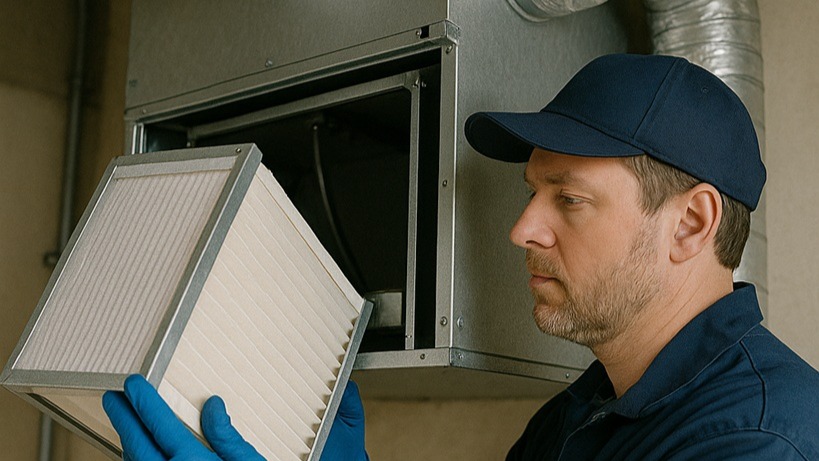Best Practices for Maintaining Heat Recovery Systems for Longevity

A heat recovery system is a smart piece of kit, but it's not something you can just install and forget about. Too often, these units are commissioned and then left untouched until something goes wrong. That kind of neglect is the quickest way to turn a major investment in efficiency into an underperforming, power-hungry appliance. Proper, routine maintenance is the only thing standing between peak performance and a slow, costly decline.
Effective HRV system maintenance isn’t about waiting for an error code to pop up. It’s about getting ahead of the problems. It’s about protecting the efficiency you paid for, keeping the air quality high, and making the equipment last far longer than its standard warranty. A neglected system doesn't just cost more to run; it will inevitably fail on the coldest day of the year when you need it most.
Why Proactive Maintenance is Non-Negotiable
Treating maintenance as an optional extra is a fundamental mistake. It’s a core part of keeping the building running properly. A heat recovery system is a critical asset; its performance directly affects running costs and the health of the people inside. Skipping a service doesn't save money; it just postpones the expense until a minor fix becomes a major failure.
Think of it like a delivery van. You wouldn't run it for 100,000 miles without an oil change and expect it to be reliable. An HRV unit running 24/7 needs the same level of care. Proactive upkeep is the difference between a system that runs for fifteen years and one that needs a major overhaul after five. This is one of the most important HVAC maintenance tips any engineer can share.
The Core Maintenance Checklist: The Essentials
Any good maintenance plan is built on simple, regular checks. These are the tasks that will catch nine out of ten problems before they have a chance to escalate.
1. Filters: The First Line of Defence
This is the big one. The filters on both the supply and extract air paths are there to protect the unit's core components and to clean the air coming into the building. As they get clogged with dust, airflow resistance shoots up. This means the fans have to work much harder, using more electricity, while the volume of fresh air drops. Clogged filters are the number one cause of poor performance, bar none. They need to be checked every three months and cleaned or replaced.
2. The Heat Exchanger Core
The heat exchanger is where the system earns its keep. Over time, fine dust can get past the filters and settle on its surfaces, acting like a blanket and stopping heat from transferring effectively. During an annual service, the core should be carefully taken out and cleaned based on the manufacturer’s guidelines, usually with a soft brush and a proper cleaning agent.
3. Condensate Drain Management
When warm, moist air cools down in the heat exchanger, water condenses out. This water is collected and removed through a condensate drain. This drain is a perfect breeding ground for sludge and mould, which leads to blockages. A blocked drain can cause water to back up inside the unit, leading to corrosion and serious water damage. The trap needs to be checked and flushed at every service.
An Engineer's Tale: The Case of the Silent System
A call came in from an office in Leeds. Staff were complaining the air was stuffy, but the facilities manager swore the HRV system maintenance was up to date. The unit on the roof was humming away, but a quick look inside told the real story. The extract filter was almost a solid brick of dust.
The system was trying to pull stale air out of the building but couldn't overcome the blockage. To compensate, the supply fan had slowed right down. The unit was burning electricity but shifting almost no air. It had been this way for months. A simple filter change, a ten-minute job, brought the system back to life. It was a sharp reminder that the most basic checks are always the most critical.
Beyond the Basics: Advanced System Checks
A truly thorough maintenance plan looks beyond the unit itself to the entire system.
Controls and Sensor Calibration
Modern HRV systems use a network of sensors for temperature, humidity, and pressure to run efficiently. If a sensor starts giving false readings, the whole control strategy is thrown off. An annual check should involve testing sensors against a calibrated device and adjusting them as needed.
Ductwork and Damper Inspection
Over time, flexible ducts can get squashed or detached, and fire dampers can seize up. A visual check of the duct runs is a vital part of a full service. It's also wise to check that balancing dampers haven't been moved, as this can create noise and ventilation problems in different parts of the building.
Hydronic Components Check
For systems that use recovered heat to warm water, the connected parts need attention, too. This means checking pumps for leaks, inspecting expansion vessels for the correct charge pressure, and ensuring any commercial circulators are operating smoothly.
Sourcing Quality Parts for Long-Term Reliability
When a component fails, the replacement you choose is critical. Fitting cheap, unapproved parts is a false economy that can hurt the system's performance and safety. It's vital to use high-quality components from reputable manufacturers.
This is where a knowledgeable supplier makes all the difference. The team at National Pumps and Boilers has the technical expertise to identify the right part for any system, stocking leading brands like Mikrofill and Armstrong. Their deep understanding of commercial HVAC systems ensures you get a component that doesn't just fit; it restores the system to its original performance. For specialist advice on sourcing the right parts for a repair or upgrade, get in touch with their team.

 -
-